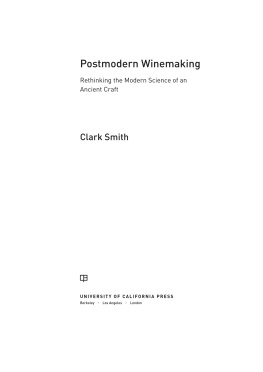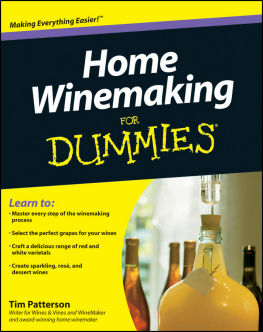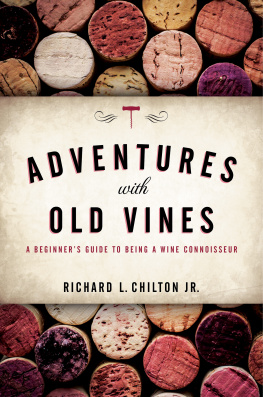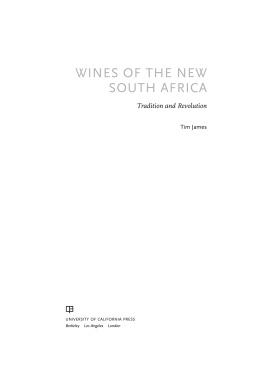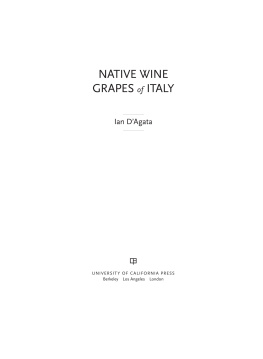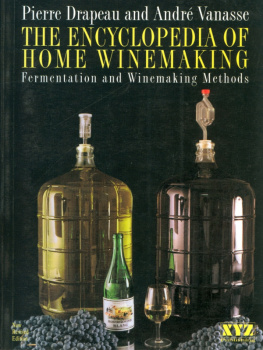
Postmodern Winemaking
The publisher gratefully acknowledges the generous support of the General Endowment Fund of the University of California Press Foundation.
Postmodern Winemaking
Rethinking the Modern Science of an
Ancient Craft
Clark Smith

UNIVERSITY OF CALIFORNIA PRESS
BerkeleyLos AngelesLondon
University of California Press, one of the most distinguished university presses in the United States, enriches lives around the world by advancing scholarship in the humanities, social sciences, and natural sciences. Its activities are supported by the UC Press Foundation and by philanthropic contributions from individuals and institutions. For more information, visit www.ucpress.edu.
University of California Press
Berkeley and Los Angeles, California
University of California Press, Ltd.
London, England
2013 by Clark Smith
Library of Congress Cataloging-in-Publication Data
Smith, Clark, 1951.
Postmodern winemaking : rethinking the modern science of an ancient craft / Clark Smith.
pages cm.
Includes bibliographical references and index.
ISBN 978-0-520-27519-5 (cloth : alk. paper) ISBN 978-0-520-95526-4 (e)
1. Wine and wine making. I. Title.
TP548.S68742013
663.2dc23
2012045797
Manufactured in the United States of America
22 21 20 19 18 17 16 15 14 13
10 9 8 7 6 5 4 3 2 1
In keeping with a commitment to support environmentally responsible and sustainable printing practices, UC Press has printed this book on Rolland Enviro100, a 100% post-consumer fiber paper that is FSC certified, deinked, processed chlorine-free, and manufactured with renewable biogas energy. It is acid-free and EcoLogo certified.
Susie
Contents
Preface
The heresy of one age becomes the orthodoxy of the next.
Helen Keller, Optimism (1903)
I have been making and selling California wine since 1972. When first I drove into the Napa Valley, I encountered a billboard that quoted Robert Louis Stevenson:... and the wine is bottled poetry. For me, that was a little over the top. I thought, Sure, I like wine, but bottled poetry? Give me a break.
I have since come to believe that this statement sprang from more than the flowery prose customary in his era; that the wines of Stevensons time were actually altogether different from ours. The modernization of winemaking in its every aspect has left us with clean, solid wines of greater consistency than ever. But they are missing something.
I hope not to bore you, my reader, while I briefly recount the professional journey that led me to this conclusion.
In 1971, I dropped out of MIT and came to California. After six years selling wines at a well-stocked East Bay retailer, I spent the next thirteen making wine in the modern way. I started off dragging hoses for three years at Veedercrest Vineyards, and in 1980 enrolled at the University of California, Davis, where I learned the principles of modern scientific enology. In 1983 I began applying those principles at the R.H. Phillips Vineyard, where the Giguiere family and I took the fledgling winery from 3,000 to about 250,000 cases in seven years.
At Phillips, I set up an extensive small-lot vinification and sensory lab and, with a series of hardworking UC Davis interns, began delving into quality enhancement in the nascent Dunnigan Hills region, presenting at the American Society for Enology and Viticulture a series of seven papers on vineyard variables affecting wine quality, based on the reductionist methodology I had learned at Davis.
A simple example. We were making White Zinfandel that had more of a canned tomato soup aroma than the fresh strawberry notes I was seeking. Accordingly, I conducted a series of small-lot duplicate trials to test a variety of vineyard variables and winemaking procedures, presenting the resulting samples to a trained panel in a double-blind setting, asking the panel to rate the samples for the aromas they found as defined by the two standards I supplied: fresh strawberries and Campbells tomato soup. Compiling the scores and running ANOVA (analysis of variance) statistical analysis, we determined significant differences due to both greater grape maturity and four hours of skin contact, which led to substantial improvement in the following years.
But toward the end my stint at Phillips, I began to hit a wall. I considered that I had learned how to make very good white wines, but my reds were, well, pathetic. Even when I sourced excellent syrah fruit from Estrella River and old-vine mourvdre from Oakley, the wines had no sex appeal. A trip to South Australia only disheartened me further. I admired the plush, deep, finely knit structure and provocative, soulful qualities of their Cabs and Shirazesand realized I had absolutely no idea how it was done.
So I did what any journeyman winemaker would do who wants to perfect his craft: I opened up a consulting firm. I had the incredible good fortune to be taken on by the Benziger Family and their winemaker (and spiritual guide), Bruce Rector, as my primary client. Like Phillips, the Benzigers Glen Ellen line was growing very rapidly, and Bruce needed to outsource several R&D projects.
These projects were to become the foundation for everything Ive done since. The first was an elaborate feasibility study on what was to become the Glen Ellen Learning Center, for me a crash course in teaching, learning, collaborating, and innovating. Second was the making of an International Claret, a global project in which I worked with the Australian Richard Smart, the Chilean Alejandro Hernndez, and Pascal Ribreau-Gayon, our project chief and director of the enology faculty at the University of Bordeaux. This project opened up for me a whole new understanding of tannins, high-pH winemaking, and red wine site selection and viticulture, besides polishing up my high school French.
The third project was the pursuit of a decent nonalcoholic wine, a dream conceived by Bruno Benziger shortly before his death, for which he had purchased a reverse osmosis (RO) filter. In nonalcoholic wine, we could work outside the federal restrictions for standard wine that forbid flavor additives, and thus I was permitted for the first time in my winemaking career to fool around with flavors.
We would choose a bland base wine and use the RO to remove all its alcohol. If it was a Chardonnay, we might then add essences like apple, pear, pineapple, and butter; if a Merlot, we might add cassis, orange peel, and vanilla.
But it didnt work. The flavors didnt blend. We ended up with what tasted like a bland base with a bunch of flavor notes sticking out as bizarrely as spiked hair. This was my first hint of the true nature of wine that this book discusses. I would spend a decade scratching my head before I understood the problem.
I now know that what was missing was the aromatic integration that good wine structure supplies. There was nothing wrong with the technology; rather, because the base wines werent made artfully, they could never accept the flavors and meld them together into a soulful singularity.
My work with RO was to earn me several patents and formed the basis of Vinovation, a wine technology company I established with Rick Jones in 1992 and operated until 2008, by which time we had over a thousand clients and had expanded our research to a wide variety of membrane technologies (see chapter 18). More interestingly, we attracted the attention of Patrick Ducournau, founder of the French innovator Oenodev, who assigned his right-hand man, the remarkable Thierry Lemaire, to train us in their system of structural levage, which includes micro-oxygenation, lees work, and a sophisticated understanding of oak. These fundamentals are the basis of postmodern winemaking (PMW) and are summarized in chapters 1 through 6.
Next page
